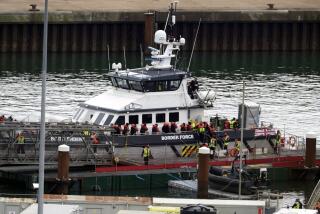Editorial: Europe must help African migrants facing death at sea

Four inflatable boats, each carrying more than 100 African migrants, recently set off from a beach near Tripoli, Libya, hoping to reach the Italian island of Lampedusa, about 180 miles across the Mediterranean. None of the boats made it: Ships rescued more than 80 people, but well over 300 perished in one of the worst migrant maritime disasters in recent years. Sadly, those deaths were preventable, and they stand as a sharp rebuke to Europe’s inadequate strategy for dealing with the numerous humanitarian crises spreading across Africa and the Middle East.
The Mediterranean migration is born of disasters, both man-made and natural. Wars, civic unrest, battered economies and food crises throughout the region have displaced more than 6 million people. Many of those hoping to reach Europe have turned to smuggling networks through Libya, where no civil authority exists to interfere. Survivors of last week’s disaster said they were robbed, forced onto dinghies at gunpoint and steered out into high winds and 20-foot seas.
That tragedy echoes an October 2013 incident in which more than 360 migrants died when a leaky 65-foot boat capsized a quarter-mile from Lampedusa. In response, Italy launched its Mare Nostrum project using navy ships and aircraft to patrol a 27,000-square-mile zone stretching to near the Libyan coast. They rescued about 150,000 people over the course of a year (many of whom resettled in other European countries), though at least 3,279 perished.
Critics of the Mare Nostrum project argued that saving migrants at sea just encourages more to try, but migration experts say that’s not the case. Nevertheless, amid complaints by anti-immigrant conservatives and lack of support from other European nations, Italy ended the $10-million-a-month rescue program in October 2014.
So what’s left? The European Union’s border agency, Frontex, patrols the waters within 30 miles of the Italian coast, but that does not help those facing death on the high seas. And Italy is continuing to do some special, one-off rescue missions (such as one Sunday that helped saved 2,000 migrants 50 miles from Libya). But that’s not enough.
The United Nations High Commissioner for Refugees and other human rights advocates have rightly called on the European Union to launch a more robust and effective system for rescuing people at sea. Nations have the right to determine who may cross their borders, but they also have a moral obligation to help those in distress on the high seas — no matter how they got there — and to save lives that are savable. Europe should not leave this human tide to fend for itself.
Follow the Opinion section on Twitter @latimesopinion and Facebook
More to Read
A cure for the common opinion
Get thought-provoking perspectives with our weekly newsletter.
You may occasionally receive promotional content from the Los Angeles Times.






